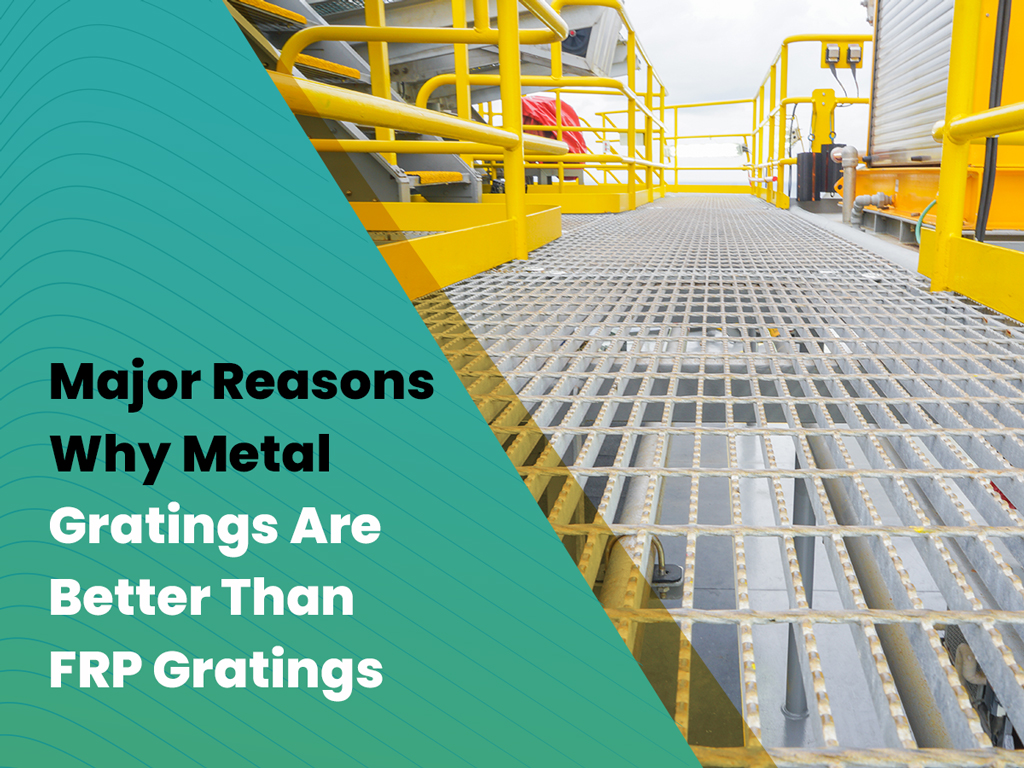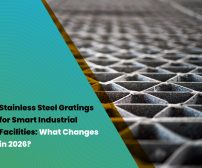
For ages, plastic has been the choicest packaging material due to its durability and mold-ability. Other materials handling (grating) options include metal and fiberglass. However, each option has its constraints in terms of usability, strength, cost, recyclability, and environmental impact. Thus, buyers must select viable options that meet their unique material handling requirements. This article shares a point of view on why metal grating is superior to fiberglass. Let’s explore.
As one of the leading Industrial Metal Grating Manufacturers in India, we’ve seen why industries across Gujarat prefer metal over FRP for long-term performance.
Steel Vs. Fiberglass (FRP) Grating:
Steel is stronger, durable, and cheaper as compared to fiberglass. For gratings that require enduring heavy loads, or are used as flooring and elevated platforms, steel is the safer option which can also take hit from metal pallet damage also. When the slip-resistant coating is applied to steel, it can be used for walkways and stairways. Further, steel is more eco-friendly than fiberglass.
Fiberglass is manufactured from strengthened plastic that releases Volatile Organic Compounds (VOCs) which mars the indoor air quality and pose health risks. Since fiberglass is exposed to UV radiation hence its integrity and durability are compromised, and it cannot be reused. Nonetheless, it’s corrosion-resistant and endures frequent water immersions, hence is used in wastewater, chemical, and food processing industries.
Why Metal Gratings Are Better Than FRP Gratings?
Intense Load Capacity:
Steel has a higher tensile strength as compared to fiberglass. Thus, stainless steel baskets can easily endure heavy loads but fiberglass would simply crush under pressure and weight as they are gone through a rigorous industrial fabrication process.
For instance, Precision Steel 301 wire has a minimum tensile strength worth 90,000 PSI as compared to fiberglass which offers a 21,755 PSI strength. Although 301 annealed steel is considered a weaker steel alloy yet it’s 4x stronger than super grade fiberglass available in the market.
Top Grating manufacturers in Vadodara, Ankleshwar, and Dahej often recommend galvanized steel gratings for high-load environments due to their structural reliability.
Heat Resistance:
Steel offers high heat resistance as compared to modified fiberglass that can endure the heat. But as we know, fiberglass is a type of plastic, and plastic is not resistant to heat.
For example, Dupont™ has manufactured heat resistant polymer called Vespel™ that can endure temperatures up to 750° Fahrenheit (400° Celsius) without melting. This temperature limit is very low as compared to the steel that has a melting point of 2,550° Fahrenheit (1,363° Celsius). Thus, steel is 3x more difficult to melt than high-quality polymer.
Steel’s high-temperature tolerance enables it to endure high oven temperatures easily without melting or losing tensile strength, hence heavy-duty material handling baskets are manufactured from steel and not from fiberglass.
Longer Working Life:
Fiberglass can easily break down due to the following reasons, which reduces its shelf-life.
- Straining of heavier loads that can break the basket’s frame
- Oxygenation of the basket that decays its molecular structure
- High temperature damaging the polymer’s bonds
- Chemicals soaking in the basket that easily contaminates it
However, a highly durable steel basket possesses a longer shelf-life due for the following reasons;
- Corrosion-resistant occurring from oxidation. Stell has a thin coating of oxides to prevent other oxides from latching onto it.
- It absorbs fewer chemicals and hence easier to remove the accumulated chemicals.
- Very high tensile strength offers stronger durability that leads to greater efficiency.
Corrosion Resistance:
Stainless steel is resistant to corrosion occurring from moisture present in water and the atmosphere. High-alloyed steel resist corrosion in acids, alkaline, and chlorine solutions. While fiberglass due to its characteristic of absorbing chemicals easily corrodes and thus has a shorter lifespan.
Versatile:
Steel can be easily coated with plastic to obtain the advantages of both products. Plastic can be molded in a few ways, but steel can be cut, welded, bent, and assembled in several shapes and sizes for multi-purpose use.
Protection against Fire:
Nickel-alloyed and chromium steel can resist scaling and retain tensile strength at high temperatures. On the contrary, fiberglass exposed to heat melts easily and releases VOCs which are harmful to the environment and people.
More Sustainable:
Plastics/ fiberglass break down much faster yet are not eco-friendly. It is manufactured from a non-renewable resource like petroleum and would cease to exist once the reserves are over.
On the other hand, steel is reusable and recyclable because it can be melted and repurposed for use.
Low Water Absorption:
Steel is water -resistant. Fiberglass absorbs water to an extent, which compromises the durability and shelf-life of the plastic or poses health hazards from bacterial growth developing on it.
Low Manufacturing Cost:
Steel utilizes simple methods to manufacture steel products. On the contrary, fiberglass requires a custom mold and expensive tools, which restricts production on a very large sacle and volume.
Conclusion:
We hope this article will help you choose the best-suited materials handling option. Fiberglass is suitable for a few use cases but steel is a widely-used, safer, affordable, and eco-friendly choice. Whether your project is in Ahmedabad, GIDC Manjusar, or GIDC Makarpura, trust a reputed Industrial Metal Grating Manufacturer in Gujarat for durable and cost-efficient solutions.






